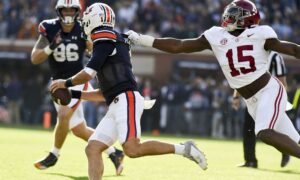Make Quarterbacks Great Again: Fixing QB Scoring
There has been a lot of talk about quarterback scoring in the fantasy community this off-season. What is often considered the most important position in pro sports isn’t really all that important in the fantasy version, and we need to fix it.
I’ve heard some great ideas on how we can accomplish this task, from James Koh’s idea of using 6-4 scoring (more on that later), to Scott Fish’s many ideas I’ve heard on podcasts and read on Twitter, to a buzzmillion others.
There have been some answers for how to fix quarterback scoring through adding a superflex position or starting two quarterbacks, but there are shortcomings there, as well. My biggest problem with 2QB leagues is that there are always at least two teams counting on a quarterback injury to cover their bye weeks. If you have to count on an injury to be able to fill out your lineup on any given week, there might be a problem with your settings.
Superflex helps with that a bit, but it still suffers from another one of 2QB’s problems – quarterbacks as a whole just score so much more than other positions. Starting two quarterbacks instead of another position is just a better option in superflex.
You can certainly win these leagues with strong management and good drafting, but it doesn’t change the fact that you are likely to see an incredibly high percentage of early picks going towards quarterbacks. Do you really want to see Blake Bortles going in the top 70 picks?
[am4show have=’g1;’ guest_error=’sub_message’ user_error=’sub_message’ ]
So, I decided I would take a look at some of these different scoring ideas to see how they played out. Some of the potential scoring systems added more variance to the quarterback, which we want, and others actually came out worse than standard 4-2 scoring (4 pts per touchdown, -2 pts per interception). Some of these ideas didn’t start with me, but others are a little more of an original creation.
I started out by looking at six different options for scoring, and then I added two small variations to the two options that I liked best. First, here’s a look at the six different options I started with.

Okay, so what are we looking at here? The QB-1, QB-6, QB-12, and QB-24 columns are the point totals for those respective quarterbacks in each scoring system. The percentage columns are how far below the QB-1 that the QB-6, QB-12, and QB-24 scored. What we are looking for is 35% or more from QB-1 to QB-12. The difference between WR-1 and WR-12 and RB-1 and RB-12 is typically 35-45%, so that’s what we should be looking for at quarterback, as well.
To more fully understand what you’re looking at, you need to know exactly what each scoring system is. Assume that every scoring system is standard 4-2 with 25 yards per point for passing and ten yards per point in rushing and receiving. All turnovers were scored the same, so fumbles and interceptions are -2 or -4 in the systems used. All differences are listed, but I’ll tell you the exact specifics below.
- Standard 4-2 with a half point per first down. (This awards a half point for all first downs.)
- 6-4 scoring with an additional -.06 points per sack yard. (This scores sack yardage like a negative run when added to the already subtracted pass yardage since sack yardage only comes out of passing yardage.)
- 6-4 scoring with yards per completion. (This awards .3 points for every tenth of a yard over 11 yards per completion and subtracts .3 for every tenth below.)
- 6-4 scoring with passer rating. (This is the system James Koh suggested in his article. Quarterbacks earn .1 point for every point of passer rating above 90.)
- 6-4 scoring with completion percentage and sack yardage. (Use the same sack yardage from above and give quarterbacks .3 points for every percent above 63% completion percentage and subtract .3 points for every percent below.)
As I started putting together these different scoring systems, it became apparent to me that 6-4 was going to be the baseline for what I wanted to use. The 4-2 system is just terrible, even worse than Keystone Light.
At first I felt confident that adding a point per first down would help, so I started with a system I’m already using in a league that awards a half point. To my surprise it’s even more broken than standard 4-2! If I would have spent the time changing it to a whole point, it would have been an enormous waste of time.
So, I scrapped 4-2 and PP1D completely for quarterbacks. This isn’t going to be what we are looking for. This left the four 6-4 systems. I calculated the straight 6-4 with sack yardage after seeing how sack yardage just slightly benefited some of the systems I had already calculated, which I will reference below. In my opinion it does just enough to deflate quarterback scoring while adding only a few tenths of a percentage point in difference between having it and not.
The following thing I looked at was how the scoring affected individual quarterbacks. It’s important to me, and hopefully you, that scoring reflects somewhat closely how perceptions of players skills really are. If a certain scoring system elevates Alex Smith to the top overall quarterback, it really isn’t working.
This is when I threw out completion percentage. Sam Bradford, Smith, Ryan Tannehill, Matt Stafford, Joe Flacco, and Andy Dalton all finished the 2016 season in the top 12 in completion percentage. Do we really want to buff scoring for these players? Check-downs aren’t indicative of good quarterback play.
Now with 4-2 scoring, PP1D, and passer rating thrown out, the last thing I looked at was how understandable each system was. I actually did a Twitter poll to see what people thought. The results were very surprising.
For a @DLFootball article, what QB stat is most indicative of good QB play while still easily understood by most fans?
— Zach Bahner (@BahnerFFett) June 21, 2017
To my surprise, quarterback rating, completion percentage, and yards per completion finished neck-and-neck. I anticipated first downs would garner a larger percentage of votes due to how much it’s been talked about as a viable scoring setting this off-season, but it seems everyone knew what I did not when I started this task of fixing scoring.
I really did not think quarterback rating would finish very high in the poll, but apparently a lot more people know how to calculate it than I thought. The formula for it is ridiculous. It’s hard for me to believe more than five people actually know how to do this.
At this point, I had to throw out quarterback rating. While it gave a great spread across the quarterback position, it is just too abstract for me. Far smarter people than I, such as Koh, understand the stat, but it just doesn’t work for me. Aside from the difficulty of calculating it, the biggest negative I have for it is you would only be awarded 6.83 points for a perfect game. What’s the point of such a small difference?
This left me with yards per completion. To me, this made sense. Yards per attempt gets lowered by passes thrown away, spikes, drops, and sack yardage, but yards per completion shows a bit more closely what kind of passes a quarterback is throwing and how well he sets his receivers up for yards after the catch.
It also just makes a ton of sense when calculating the stat. It’s easy to figure out how many yards per completion a quarterback is throwing for, just as easy as completion percentage and many other stats we naturally calculate in our heads.
This is when I set the benchmark at 11 yards per completion. This was 22nd in 2016, 27th in 2015, and 25th in 2014. Bumping it to 11.5 yards per completion puts us in the 16th-ranked quarterback range, but it also increases the number of quarterbacks finishing with negative points outside of the top 15 quarterbacks somewhat significantly.
We are trying to fix the quarterback scoring, not completely ravage the league average, and we do need viable bye week quarterbacks, even if they aren’t likely to put forward stellar production.
The last component I wanted to look at was how much adding sack yardage would change 6-4 with YPC scoring.

What I found was it deflated the quarterbacks just right. Quarterbacks are still going to dominate the top 30 overall scorers, but the scoring isn’t so inflated that it makes it necessary to draft the top 12 quarterbacks within the first few rounds.
With 6-4 with YPC and Sack Yardage Scoring, we have a balanced, tiered scoring system for quarterbacks. The position actually matters again in fantasy. It actually makes sense to draft a few quarterbacks in the top 20 picks. Late round quarterback would leave your team absolutely in dire straights. Streaming would all but doom your team to a purgatory of lite beers and CD Carter takes.
I am not going to go so far as to say this should be the new standard for quarterback scoring. I think it works extremely well, but I also think standardizing the scoring is a part of the reason we have seen streaming, late round quarterback, 2QB, and superflex move to the forefront. Having a little bit of complexity to quarterback scoring without forcing an algebraic equation into the mix is going to draw more attention to the most important position in sports.
I would love to hear of the other good scoring systems you have come up with. One thing I am absolutely certain of is 4-2 scoring needs to go away. It isn’t going to win you championships, and it certainly isn’t indicative of the importance of the position. I’ll be back soon with some other scoring possibilities for other positions. If we try hard enough, we can make scoring great again.
[/am4show]
- Summer Sleeper: Buffalo Bills - September 5, 2017
- Summer Sleeper: Miami Dolphins - August 14, 2017
- How Broken Is Running Back Scoring? - July 9, 2017


































































